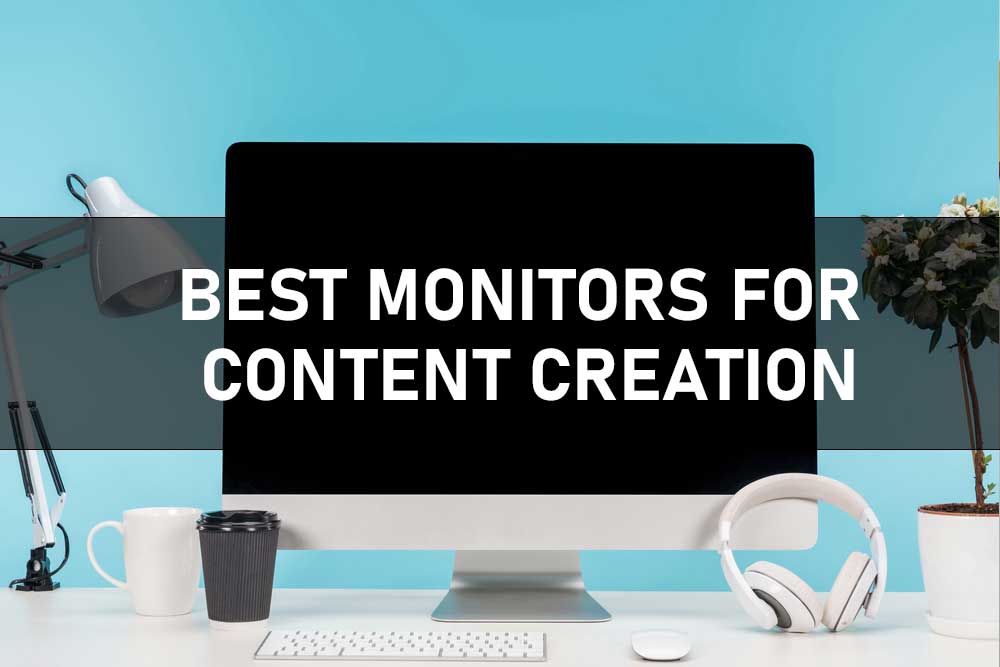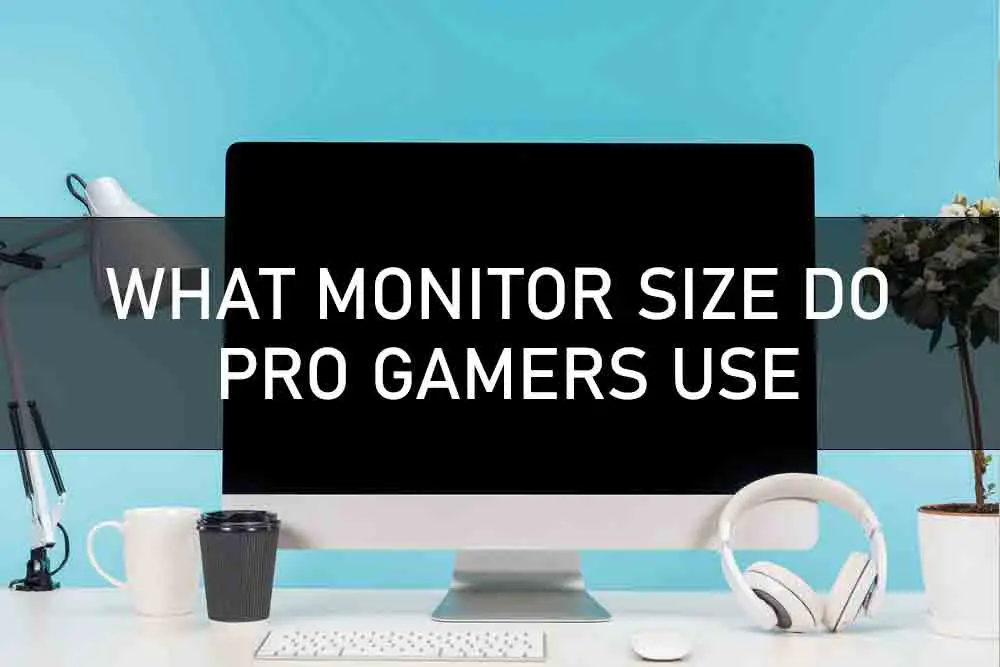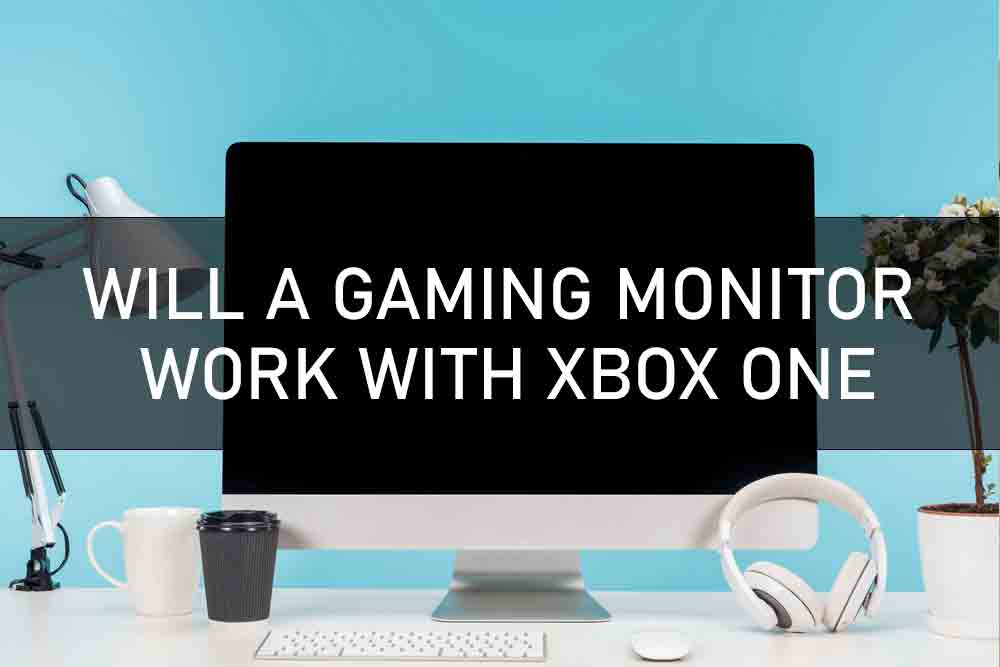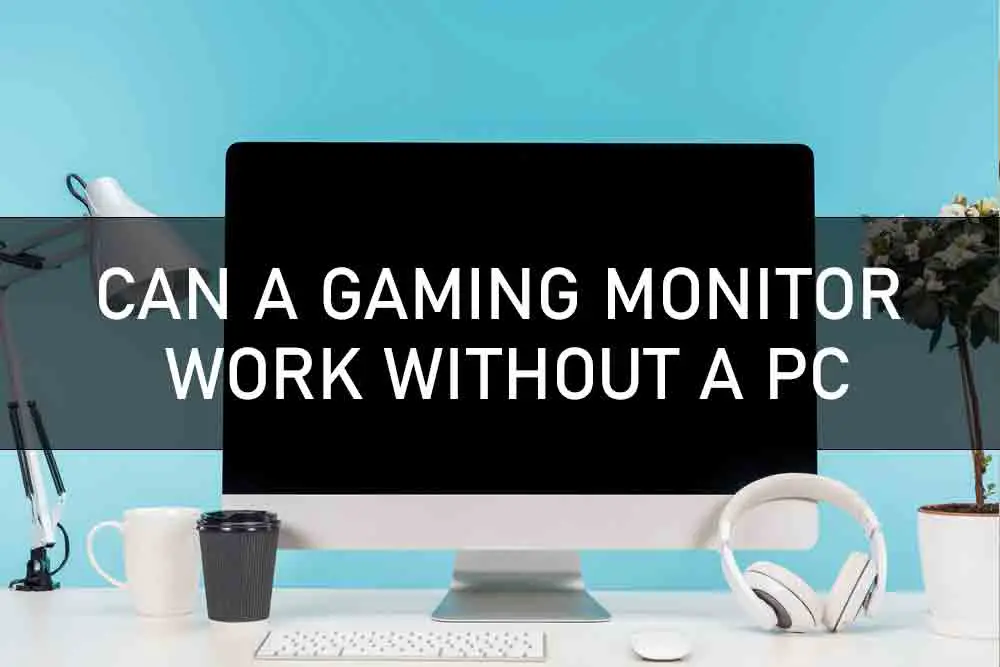The best monitors for content creation will always be the ones that allow you to get your work done in a timely manner. Given this, it’s important to have a monitor with high resolution and color accuracy.
You also want one with wide viewing angles so you can see what you’re working on from a variety of different angles without having to move your head too much. The best monitors should also be compatible with multiple operating systems, have built-in speakers or an audio jack, and last but not least they need to have fast response times when interacting with them! Read more below about the top 10 best monitors for content creators!
What To Look For In A Monitor?
To ensure you get the best monitor for content creation, there are a few things to look at:
- Resolution: You want your monitor to have enough resolution so you can clearly see what you’re working on and so that fonts and images won’t appear blurry.
- Size: Keep in mind how much space you have available on your desk for a monitor. You want to make sure the size of your monitor is actually worth it before you purchase one!
- Refresh Rate: This is how quickly a monitor can refresh, and the faster the better. This will ensure you have an excellent viewing experience with no flickering or lag time when interacting with your device.
- Connectivity: As a content creator, you want to make sure this monitor is compatible with your current and future devices.
- Response Time: This will ensure that while you’re working on your monitor there’s no lag time! We all know how frustrating it can be when we’re scrolling through something (like this article), and it takes an extra second or two to get it to respond!
- Speaker/Audio Jack: This is something that more and more content creators are using. If you want speakers, make sure your monitor has them built-in, or an audio jack if they’re external. Also keep in mind that not all monitors have speakers built into them, so be aware of this before you purchase your monitor.
- Built-in USB Hubs: This is a really cool feature that many content creators are using, especially if they have multiple devices to the plugin. It’s always annoying to need an extra cable or two for each device! Make sure your monitor has at least one built-in USB hub.
Top 10 Best Monitors For Content Creators
If you are looking to purchase one of the top 10 best monitors for content creators, then check out the list below!
Best Ultrawide Monitor – Best Ultrawide Monitor for Video Editing
Professional Monitors
Ultrawide Monitors
Best Video Editing Monitors – Monitor for Video Editing for Most People
View Sonic Vp2468 Monitor – Most Ergonomic Display for Video Editing
- SIZE: 24″ IPS display
- RESOLUTION: 1920 X 1080
- REFRESH RATE: 144Hz
- RESPONSE TIME: 1 ms
- PANEL TYPE: IPS
- ADAPTIVE SYNC: G-Sync
- I/O PORTS: 1 × HDMI, 2 × DisplayPort
The ViewSonic VP2468 is a professional monitor, with 1920x1080p resolution and full HD (1920x1080p) at 60Hz. The display has wide sRGB, EBU, SMPTE c, Rec. 709, and Dicom sim color uniformity for displaying precise colors to deliver life-like images.
This features an ultra-thin design that moves the LCD panel closer to the user’s eyes providing greater viewing comfort than traditional monitors without sacrificing performance or picture quality. Optimized Ergonomics provide utility by enabling users to flexibly adjust the height (+5°/-5°), tilt (-10°/+60°), swivel (clockwise/counterclockwise 360°), and pivot between landscape and portrait viewing. Connectivity consists of HDMI 1.4, USB, DisplayPort mini DisplayPort, 3-year warranty.
Which Monitor Type Is Best For Graphic Design?
A lot of people use incorrect terms to refer to some models, which causes a bit of chaos in online forums and throughout most websites. As such, it’s important to be clear on precisely what I’m referring to with each term below:
- LCD monitors: Standard computer monitors that are able to display both videos and images. These are the most common type of monitors used by graphic designers today, thanks largely to their affordability and good image quality.
- Ultra High Definition TVs: The newest type of TV, which are normally referred to as ‘4K’ monitors due to their vertical resolution of 3840 pixels. Although they have some use for graphic design work, since they can display images at multiple resolutions without any need for scaling or interpolation, their small size makes them impractical for extended use even by those who can afford them. For the purposes of this article, they will not be covered any further.
- OLED monitors: The most expensive type of monitors for graphic designers, these are only just beginning to become available in affordable models. They have several advantages over standard LCD monitors that make them suitable for designers, but they’re still very new and relatively rare – so the market is not yet mature enough to accurately compare their pros and cons. For this reason, I’ll only be covering them in detail if/when they become more common.
- IPS monitors: These are probably the most common type of monitor for designers right now, thanks to their combination of good image quality and affordability. They’re generally superior to LCD monitors in every way except for maximum brightness, with much better viewing angles and color reproduction than any other type of screen on the market.
- VA panel: These are the other common type of monitors for designers, typically being slightly more expensive than IPS but having better black reproduction and contrast ratios. They’re also sometimes (but not always) able to display images with less ghosting than IPS screens can.
What Is The Best Type Of Monitor For Video Editing?
Video editing almost always requires a screen with high brightness and high contrast ratio, along with some way of displaying more than one image at a time. This means that the only real solution is an OLED monitor. These will be released by many manufacturers in various shapes and sizes over the coming years, but they’ll always be very expensive until the market is more mature.
For this reason, you should not buy any monitor simply because it’s advertised as being suitable for video editing – unless it offers other advantages over OLED screens that are also useful to graphic designers. For instance, if it has a high refresh rate or low input lag, so long as it’s also fairly affordable.
What Are The Best Monitors For Photo Editing?
This will depend on your specific needs, so there is no one correct answer. If you need to display a lot of images at once, then IPS monitors are definitely your best bet. However, if you mostly work with landscapes and don’t have many images open at once, then standard LCD monitors are just as good.
In terms of specific manufacturers and models, I’ll leave that up to you – but if you want a monitor with a built-in camera or USB 3.0 hub, then you should definitely ensure your desired model has those features before purchasing it. The only real reason for preferring one specific monitor over another is if it has a resolution that’s better suited to your needs, but even then this isn’t too important as long as the difference isn’t too significant.
What Is The Perfect Screen Size For Graphic Design?
There really isn’t a ‘perfect’ size – but there are several things you should keep in mind when choosing your screen size. Firstly, try to avoid choosing too large of a monitor for your work – since the smaller the screen is, the less likely it is that you’ll be forced to use Windows scaling features.
Secondly, you should also keep in mind what kind of tasks you will be using it for most often. Working on photos requires larger screens than working on smaller graphics, for instance. For the highest possible image quality, you should choose a monitor with a 4K resolution and a screen size of at least 40″ – but this combination is unaffordable for most people, which means that 24-32″ screens are generally better suited to photo editing.
Is 144Hz Good For Video Editing?
Primarily, your CPU and graphics card is the bottleneck for anything you do on a computer, which means that these have far more of an impact on performance than the monitor does. For example, even if you have a 144Hz monitor capable of displaying 144FPS, this will not be as useful as a lower monitor that’s capable of displaying more images per second.
However, it is true that a higher refresh rate may lead to better performance with certain software – so for this reason there is indeed a benefit in choosing a 144Hz monitor over a 60Hz model or even an IPS one over a standard LCD monitor. If you do not want to spend too much money, then IPS monitors are the best video editing monitor- but if you can afford it, then a 144Hz G-Sync monitor would be the most ideal solution.
Is HDR Good For Graphic Design?
Not really, no. HDR monitors are not yet suitable for photo editing since they cannot reproduce a wide range of colors – and as such, they don’t offer any advantages over standard graphic design monitors. In fact, their lack of color accuracy may actually make them worse for professional use rather than better – but at least high-end models can display more accurate colors than standard LCD monitors.
There is little reason for most people to purchase HDR monitors, though they may be more useful in the future when displays such as 8K or 4K become affordable and HDR support becomes a standard feature on consumer-grade models. For now, it’s best to just ignore this option – but if you do want to invest in an HDR monitor, then wait for the technology to mature before doing so.
Does Refresh Rate Matter For Content Creation?
Yes, but only in specific situations. For normal use with software such as Office apps or web browsers, a low refresh rate is perfectly fine – and you will not be able to notice any changes between different rates. However, if your work regularly involves video games or high-performance software like video editing suites, then it is important to choose a monitor with a high refresh rate to ensure optimal performance.
What Refresh Rate Is Best For Editing?
For the best possible workflow, a monitor with a refresh rate of at least 120Hz is recommended – but for most users, even 60Hz is fine. Editing videos requires a high frame rate to ensure that you can view footage as it will appear when exported or played back in real-time, which means that refresh rate should be prioritized over resolution.
Do You Need a 4K Monitor For Editing?
For photo editing, it doesn’t make much of a difference. If the client needs your photos in 4K (3840×2160) resolution then it’s good to have that option – but if they just need them at 1080p or lower, then you can save money by getting a cheaper monitor with full HD resolution.
On the other hand, video editing requires a 4K screen since most high-quality videos are exported in this resolution. If you’re working on smaller projects with small budgets and tighter deadlines then it’s fine to work on 1080p – but for longer projects or higher-end studios that require more time and resources, then the investment will be worth it.
How Much Storage Do I Need For Hd Video Editing?
Video editing requires a lot of space, which means that low-storage computers are not suitable solutions. If you only have enough place for the video editors and your media files, then it’s possible to get by – but if you want to edit videos or photos afterward (such as with Adobe Premiere Pro), then you will need at least 1TB of space between your hard drive and any external drives that may be connected.
Is an SSD Good For Video Editing?
Yes, definitely! As long as it is large enough to meet the requirements of the software you’re using – which in most cases means 256GB or more. The speed can also be important depending on the software, so it’s best to avoid getting models with too small of a storage capacity – but in general, SSDs do not need to be as large as HDDs and can work well even if they are only 256GB.
Does Editing Take Up a Lot Of RAM?
Yes, especially when working with 4K or 8K footage. It’s best to go for 16GB of RAM if you can afford it – but otherwise, the minimum requirements are usually around 4-8GB depending on the software. Most video editing software is optimized to run smoothly with Windows 10 so make sure you have an up-to-date version installed before buying any new hardware.
Should I Buy a 4K Monitor For Photo Editing?
4K is not necessary when it comes to photo editing, especially since most pictures are taken in standard HD resolution (1920×1080). While there are benefits to using an ultra-high resolution screen – such as better color accuracy and more accurate colors – you will not get the same level of detail and clarity that you would by editing photos in 4K.
If you’re looking for a monitor to edit your photography and don’t need it to be 4K, then the best solution is one with a large resolution (1080p or higher). Not only will this ensure smooth performance when editing – but it will also ensure that you have enough screen space for your photos and tools.
What is Better 4K or 1440p?
4K is better. This doesn’t mean that 1440p isn’t an option – but in general, most people will find it more convenient and easier to edit videos and photos with a 4K screen than a 1440p one.
Do You Need an IPS Panel Monitor For Video Editing?
IPS screens are not necessary when it comes to video editing, but they can be useful if you need to edit your footage in an unfamiliar location or are often on the move.
You may also find it useful if you don’t have a large desk or dedicated editing space since IPS panels are usually thinner and will take up less room. Having said that, most people get by just fine with TN screens – and the only thing you’ll be losing by going with a TN panel is color accuracy and viewing angles.
Should I Edit in 4K or 1080p?
The terms 4K and 1080p refer to the resolution of a video or photo. 4K refers to a total pixel count of roughly 4000 x 2000, while 1080p is only 1920×1080 pixels. Therefore, there’s no reason why you can’t edit in either one – but keep in mind that most monitors (especially HD ones) do not have enough screen space for you to see and work with images that are larger than 1080p.
Is 1440p Enough for Photo Editing?
There are benefits to using 1440p monitors when editing photos, but it is definitely not the best option. The most common reasons for choosing a 1440p monitor are cost and screen real estate – but 4K screens provide better image quality, more accurate colors, and enough space for your tools without requiring you to re-scale them.
Is 16GB of RAM Enough for Photo Editing?
This will depend on your particular needs and the software you’re using, but in general 16GB is more than enough for most photo-related tasks. This includes standard functions such as exporting/saving images or making small changes to a few photos at a time – however, modern photo editing software also has some pretty hefty requirements in terms of CPU power so it’s best to go with 8-16GB if you’re working on high-resolution photos, videos, or with multiple images at the same time.
Which Monitor Is Best For Content Creation?
The best monitor for content creation is one that has a 4K resolution or greater. Since you are working with graphics, it’s important to have the ability to view high-resolution images without pixelation. The sharpness of the image will be able to affect your overall experience when creating content.
What Do I Need To Consider When Looking For A Monitor?
For content creators, the ability to have an accurate color representation is important. With the best monitors for content creation, you want one that has great viewing angles so you can see what’s on your screen clearly even when you’re not directly in front of it. The response time matters since you’ll likely be doing some heavy-duty gaming from time to time. You don’t want a monitor that lags or takes forever to load up a new page!
Are Curved Monitors Bad For Content Creation?
No, curved monitors are not bad for content creation. With today’s modern technology, it is very unlikely that you would have any issues with color representation or lag time when using a curved monitor.
What Makes A Good Monitor For Photo Editing?
If you are looking for a monitor to use for photo editing, choose one that has at least 4K resolution. You also should look for great viewing angles so the image on the screen is seen correctly from various angles. Some monitors will have an sRGB color setting which is ideal for photo editing applications since it offers more accurate colors than other settings.
What Makes A Good Monitor For Video Editing?
Choosing the best monitors for video editing is all about size. You want one that is big enough so you can see most of your timeline at once without having to constantly scroll up and down. Having an accurate color range will help with grading footage in post-production. Some settings are more accurate than others so it’s important to choose a monitor with an sRGB mode.
What is Adobe RGB Color Space and Monitor?
Adobe RGB color space is larger than the gamut of sRGB color space. Adobe RGB can represent more colors than sRGB. Adobe RGB has a wider color gamut than most monitors which by default, are calibrated to have a standard gamut of sRGB or NTSC or Rec. 709 which has a similar aspect as sRGB. Adobe RGB is also used in printing.
Is An Ultrawide Monitor Good For Video Editing?
Yes, But it depends on how you define “good”. With a wider monitor, the timeline in your NLE software moves from left to right instead of up and down. This, in itself, can be a problem for video editors used to working with a traditional 16:9 monitor.




















